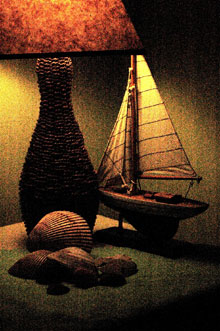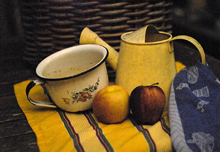
Figure 1. The deep-sea chirostylid anomuran crab, Eumunida picta, as viewed under typical submersible lights (left panel), as corrected for the color of light in the deep sea (middle panel), and as corrected for color and also for the typical (and relatively poor) visual acuity of a deep-sea crab (right panel). Click image for larger view and credits.
Seeing in the Dark:
Imaging at Low Light Levels
Sönke Johnsen, PhD
Assistant Professor
Duke University
There are essentially no images of the deep-sea floor under natural light. Instead, all our images are taken under full-spectrum floodlights. The floodlights are problematic. Not only do they impact the animals — disturbing their behavior, chasing them away, and/or even permanently blinding some — they give us a false view of the deep-sea world. Modeling based on imagery and methods from previous Ocean Explorer (OE)-funded cruises has shown us that the actual visual world of deep-sea animals is quite different from what submersible video shows us (figure 1). Models are a poor substitute for actual images, however, particularly for this expedition where constant benthic (on or near the sea bottom) bioluminescence could dramatically affect how the deep-sea world appears to its inhabitants.
Unfortunately, bioluminescence is very dim. We can see it with our dark-adapted eyes, but taking clear video and pictures of it has been nearly impossible. Before I talk about how we will manage to capture images of bioluminescence, let’s first consider why it’s so hard.
Suppose you want take a picture of your friend under the full moon, and you want to use a film camera. You buy some high-speed film (e.g., Kodak’s ISO 400) and put a good lens on your camera. By “good,” I mean one that lets in a lot of light. In both cameras and eyes, this is denoted by something known as the f-number, which is the focal length of a lens divided by its diameter.
Your average zoom lens has an f-number of about 4.0, which is okay, but not great. A really good lens will have an f-number of 1.4. They do make lenses that go down to f1.0, but they cost at least 10 times as much as an f1.4 lens. One of the things deep-sea animals do to see better in the dark is to have lenses with very low f-numbers. Some even get down to the absolute limit of f0.5, though by this point the image quality is terrible.
The amount of light that gets to the film is inversely proportional to the square of the f-number, so your f1.4 lens lets in 8 times as much light as your average f4.0 lens (8 = 16/2). Unfortunately moonlight is 500,000 times dimmer than sunlight, so we’ll need to do more than install a nice lens on our camera.
The other thing we can alter is the shutter speed. Your typical shutter speed is around 1/100th of a second. In fact, there’s something called the Sunny 16 rule that says that if your lens is f16, then to get a good picture under sunlight, your shutter speed should be 1 divided by the film speed. So, with our 400 speed film, the shutter speed with our f1.4 lens (which lets in 128 times as much light as an f16 lens) would be 1/50,000th of a second in daylight. So to get a good exposure under the full moon, we’d need an exposure time of 10 seconds (500,000 x 1/50,000 = 10 seconds). Incidentally, deep-sea animals can also control their "shutter speed" by letting their photoreceptors count more photons before they look at the result. It’s called temporal summation, and we have studied it on previous OE cruises.
So, with an exposure time of 10 seconds, we’re obviously not going to be photographing anything that moves and we’ll need a tripod. However, it seems doable. So you get a tripod, tell your friend to hold still, take her picture, and send the film off to be developed.
You get the photos back — and they’re black! What happened? It turns out that film suffers from a fault called reciprocity failure. The chemistry of it is complicated, but essentially film is not good at seeing dim light. How bad it is depends on the film and the light level. With our Kodak 400 film, we should have used an exposure time of 50 seconds not 10. With dimmer light, things get even worse. Suppose you want to take a picture under starlight and calculate that the shutter should stay open for one hour. For this Kodak film, you’d actually need to keep it open for over 12 hours. That’s the whole night, which explains why you haven’t seen many pictures of the world under starlight.
Of course, we now have digital cameras. The sensors on these can be quite sensitive. Your average consumer digital camera has a top speed of about ISO 1600, four times better than fast film. It also doesn’t suffer from reciprocity failure. So you get out your Epson Stylus, set it to ISO 1600, and take another picture of your friend under the full moon. This time, since the film is four times faster, we only need a 2.5-second exposure instead of a 10-second one.

Figure 2. This image was taken under low light with a consumer camera set at ISO 1600. Click image for larger view and credits.
No need to send the image off, you can look at it right away. And it looks like garbage! The image is bright enough, but looks like it was shot in a colored snowstorm. You can hardly make out any fine details at all (figure 2). What happened?
The mess you’re seeing is due to what is called noise. Camera noise has two main sources. First, when light gets very dim, its discrete nature becomes more obvious. In other words, you start to notice that more photons fall in one place than another by chance, just like a light rain shows individual, randomly scattered wet spots on the sidewalk. You can fix this photon noise by collecting more light. Since we’ve already got a great lens, this means keeping the shutter open longer. Unfortunately, this makes the second source of noise even worse. This second source, know as dark noise, is the real problem. Basically, the sensor in a digital camera is not perfect. Sometimes it says there is light, even when there’s not. The longer you leave open the shutter, the worse this gets. Eventually the image gets lost in a "colored snowstorm."
Luckily, there is a solution. In fact, there are three of them. First, you can make the pixels larger. A larger pixel collects more light, just like a large bucket collects more rain. This means that you don’t have to leave open the shutter as long. So you end up reducing both photon and dark noise. Nocturnal (active at night) and deep-sea animals do this as well, wiring together multiple rods (rod-shaped cells that respond to dim light) to make one big rod that collects more light. We do this too; each pixel of our vision at night is due to about 90 rods wired together.
So why don’t all cameras have huge sensors? Mostly because, until recently, it was very hard to make a large sensor. Also, the bigger the sensor, the larger the camera and the lens have to be. This makes everything heavier and more expensive.
A second solution is to measure the dark noise ahead of time and then subtract it from your image. A nice thing about dark noise in camera sensors is that it’s pixel specific: some pixels have a lot more dark noise than others. So you can take a “dark” picture and then subtract it from your "real" picture to get rid of a lot of the noise. At the moment, we don’t know if any animal performs this exact trick.
Finally, you can cool the sensor. Colder sensors have less dark noise, and some fancy spectrometers and imaging systems are actually cooled with miniature refrigerators. How much benefit deep-sea fish eyes get from being very cold — it’s only about 4º Centigrade (39º Fahrenheit) at depth — is still an open question.
On this cruise we are taking advantage of several recently developed cameras that allow us to take good pictures and video in very low light. One, a video camera, actually intensifies the image before recording it. Intensified video cameras are nice, but have limited resolution and usually no color capability. The other camera is Nikon SLR (D700) that has a large and extremely sensitive sensor. It has a maximum ISO rating of 25,600 and very low noise. I grew up being excited by ISO 400 film, so these new cameras blow my mind. The D700 also allows you to subtract a dark image to reduce the noise even further. With it, we can take good pictures under very dim light (figure 3). Hopefully, it will allow us to get the first clear images of the deep sea under natural illumination.





















